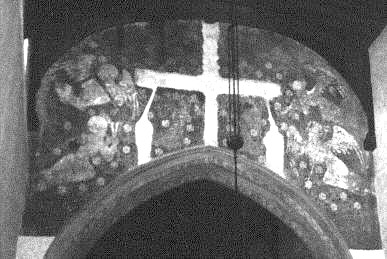The Detached Crucifixion
Introduction & Links

By ‘Detached’ Crucifixion I mean those few left in the English Parish Church which appear not to have been part of a Passion Cycle but were always intended to stand alone as single paintings. The fact that there are few of them is probably due to the presence in almost every church of the great Rood showing Christ on the Cross, usually mounted on the Roodbeam across the chancel arch. At Raunds (pictured left) in Northamptonshire the outline of the long-gone Rood, with (probably) Mary and John, still shows against the painting of Angels behind it on the chancel arch. Where the detached Crucifixion is painted on the wall, it is often in effect an altarpiece, as at Brent Eleigh (link in table below).
It is hard to generalise from so few remaining examples, but all those known to me are devoid of the accreted or legendary elements so often found in the Passion Cycle (complete or otherwise) such as Longinus and Stephaton (the Two Thieves spoken of in Matthew and Luke are rarer in either context*, but they are present in several of the paintings in the table below). Some early books on English Medieval Wall Painting try to differentiate between ‘narrative’ and ‘devotional’ paintings and although this was never a very satisfactory distinction, it is fairly obvious that a Crucifixion painted above the altar on which the Elements are consecrated and the Sacrament takes place is performing a different function from a Crucifixion scene as part of the painted narrative, with all its scope for dramatic treatment and painterly imagination, of the Passion Cycle.
* Not so rare as all that, evidently. Two examples, from Barnby in Suffolk and Wisborough Green in Sussex, are now on the site and in the table below. They also appear in the Passion Cycles at Amberley and Crostwight.